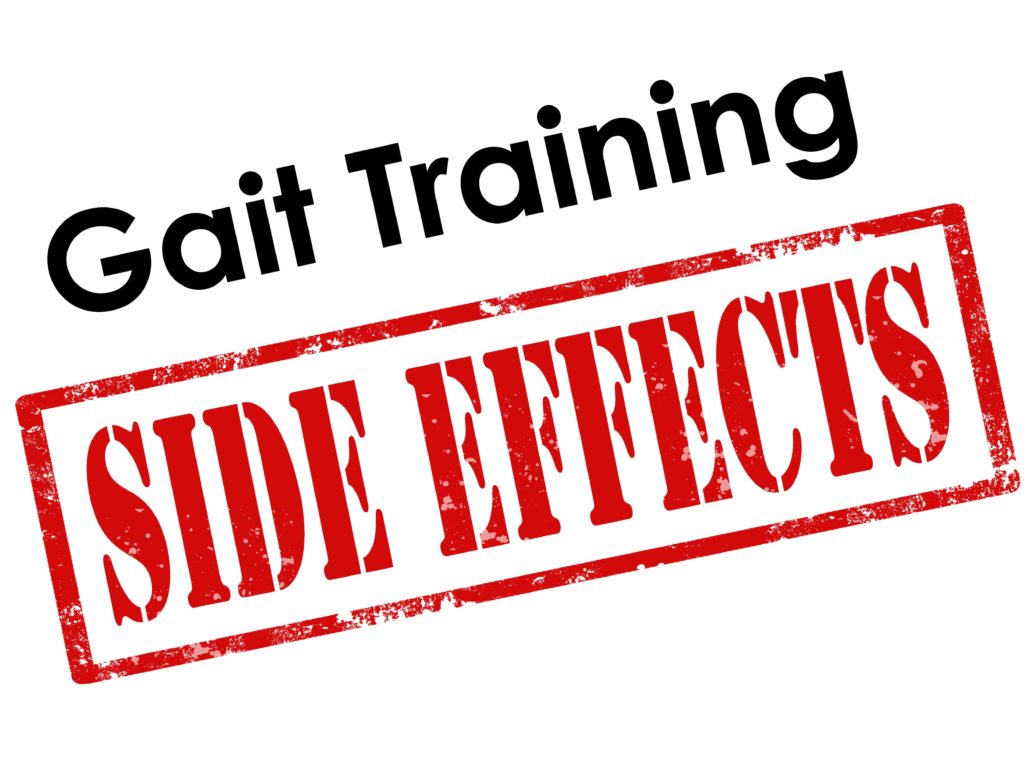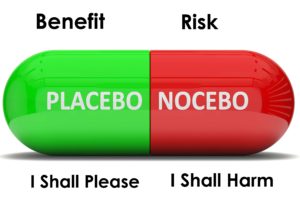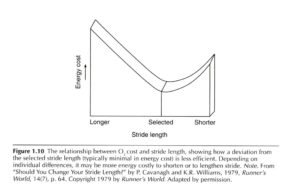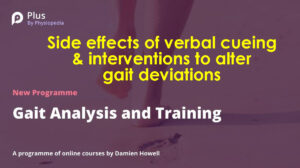Side Effects Occur During Gait Training

A side effect is a secondary effect, typically undesirable effect of a drug or medical intervention. Any intervention that can produce a therapeutic effect can also produce side effects or adverse effects.
The current standard of practice is to provide informed consent before beginning evaluation and treatment. Informed consent includes identifying the benefits and the risks or potential side effects of the intervention.
An editorial by Evert Verhagen in the British Medical Journal suggests healthcare professionals should be more proactive in sharing the adverse effects of the common intervention of physical activity and exercise. He remarks exercise has health benefits, but exercise can lead to injury. The adverse effects should not be ignored and there is a need to mitigate the side effects.
Comparing the use of Physical Therapy interventions to pharmacological interventions there is a difference relative to the quantity and quality of discussion of side effects of interventions. My observation is Physical Therapist may briefly discuss potential side effects of their interventions or do not have the discussion at all. Whereas when drugs are prescribed, we are always inundated with volumes of detailed information about the potential side effects of the prescribed drug.
One reason for this difference is Physical Therapy interventions are rarely invasive and are generally less risky than other services in modern medicine. Actuarial evidence of this is the relatively low premiums for Physical Therapy malpractice insurance compared to high premiums for surgeons. Medical malpractice insurance premiums annual cost can be $7,500 per year versus insurance premiums for Physical Therapist is $200 per year.
The fact that the potential risk of undesirable or adverse effects of Physical Therapy intervention is low does not mean risk does not exist.
I suspect Physical Therapists like many individuals have a reluctance or are averse to discussing potentially negative results or side effects. We all want to “put one’s best foot forward”. A nocebo effect can occur. The disclosure of the side effect may itself induce an adverse effect through a mechanism known as “nocebo effects”. The effect is produced by psychological or psychosomatic factors. Nocebo effects are the opposite of a placebo effect. There are ways the Physical Therapist can address the challenge of balancing between placebo versus nocebo effects by contextualization.

The context of managing placebo and nocebo can include what the therapist or patient brings to the interaction; the relationship between the two; features of the intervention; and features of the environment. There are steps actions a physical therapist do to minimize the negative effects of sharing side effects.
When Physical Therapist and/or the patient is proactive in knowing and attending to detrimental influences of the intervention they are better able to manage, mitigate, or neutralize the detrimental effects.
Knowledge of side effects helps the decision process of adjusting the intervention to discontinue; stay the course; decrease dosage; or increase the dosage of intervention.
Side Effects of Gait Training
A common intervention Physical Therapist utilizes is gait training. Gait training has side effects.
My experience side effects can occur in response to consciously altering gait. Three common side effects of consciously altering gait are cognitive overload, increased energy expenditure, and muscle soreness.
Side Effect of Cognitive Overload is a situation where there is too much information or too many tasks for the learner to process. This can result in the learner being unable to process the information. When a verbal cue is provided such as taking shorter steps more steps per minute the client's initial response to the question “what do you notice is “it feels weird and do I have to think about this all the time”. Often this is an expected side effect. Given this information the healthcare professional and patient can decide to discontinue; continue; decrease the dosage of verbal cueing or choose an alternative cue to alter gait deviation. Frequently as the client continues to practice the novel conscious alterations of gait pattern the pattern becomes automatic.
Side Effect of Increased Energy Expenditure: The concept of “path of least energy expenditure” is Individuals automatically choose a particular step or stride length because it takes the least amount of energy.
Requesting a conscious effort to either shorten or length step length will result in greater caloric expenditure. Notice in the graph the preferred stride length least energy expended.

A long stride increases the risk of injuries such as stress fracture and plantar heel pain.
However, shortening a step or stride length while increasing the number of steps per minute can have beneficial effects lowering impact loading reducing the risk of injury, and assisting with a weight reduction program.
A short stride length can be associated with an increased risk of falling. A conscious effort to increase the speed of walking can decrease the risks of falls.
My belief is given time to practice shorter strides or longer strides the body adjusts to a new set point and the altered gait becomes efficient less energy is expended. The shape of the curve in the figure above stays the same it shifts either to right or left.
Side Effect of Muscle Fatigue & Soreness: Utilizing muscle in a novel way can have positive effects such as improving strength but during the process, individuals will experience a sensation of muscle fatigue or possible delayed onset muscle soreness.
Richard Souza and colleagues provide a starting point for analyzing and consciously altering gait. They identified 16 different gait deviations that can occur running. The deviations identified are applicable to walking. Each gait deviation can be altered by verbal cues. Walking or running in a relatively novel way will likely cause muscle fatigue and soreness.
The following table lists some of the common gait deviations that can occur walking or running, a brief description of conscious alteration followed by likely muscle groups that may have side effects of fatigue and soreness.
Table: Gait Deviation & Conscious Alteration of the Deviation - Potential Muscles Which May Experience Fatigue/Soreness
| Gait Deviation & Conscious Alteration of the Deviation | Potential Muscles Which May Experience Sensation of Fatigue or Soreness |
| Too long step/stride to shorter steps more steps/minute | Thigh and/or calf muscle soreness |
| Heel strike runner to mid-foot strike running | Thigh &/or calf muscle soreness |
| Foot crossing mid-line to not crossing mid-line | Hip muscles |
| No daylight between knees to having daylight | Hip muscles |
| Early heel off to appropriate heel of timing | Stretching sensation in calf muscles |
| Prolonged heel off to appropriate heel off timing | Sore foot and/or calf muscles |
| Excessive dorsiflexion of the big toe to normal dorsiflexion of the big toe | Sore foot muscles |
| Excessive lateral pelvic drop to a stable pelvis | Sore buttock muscle |
| Excessive inward rotation of thigh to normal hip rotation | Sore buttock muscle |
| Excessive up and down motion to the normalization of up-down motion less bouncy | Stretching sensation in calf muscles & sore thigh muscles |
| Decreased up-down motion to normal up-down motion | Sore calf muscles |
With practice, the muscles can adapt to the novel manner of walking or running, and the muscle fatigue and soreness will resolve.
Key Points:
Patients can ask, what side effects should I look out for? What should I do when they occur?
Clinicians need to be proactive regarding sharing potential side effects. Clinicians can increase a patient’s level of engagement by sharing potential side effects. Sharing potential side effects can facilitate timely adjustments of chosen intervention.
Clinician's decisions regarding what information to share regarding side effects of the chosen intervention are overtly or covertly made. If the clinician decides to withhold sharing some of the details of potential side effects because of the potential nocebo effect the clinician still needs to what are potential side effects and have plans to mitigate and address them when they manifest.
An on-demand video webinar exploring this topic is available at Plus by Physiopedia entitled “Side effects of verbal cueing & interventions to alter gait deviations”.
Use this code – “Damien30” for a 30% discount to access this webinar as well as the more than 500 continuing education webinar courses available at Plus by Physiopedia. This is the link http://bit.ly/DAMIEN30 with the 30% discount code embedded.
The information on this website is not intended or implied to be a substitute for professional medical advice, diagnosis, or treatment. You are encouraged to perform additional research regarding any information contained on available through this website with other sources and consult with your physician.
Damien Howell Physical Therapy – 804-647-9499 – Fax: 866-879-8591 At-Home, At Office, At Fitness Facility – I come to you, I do home visits Damien@damienhowellpt.com

